#logographic script for an inflectional language?
Explore tagged Tumblr posts
Text

Eīaşu ouilonio itu eīþei.
Cry on the flowers when you cry.
Because I’m attempting to design the system to be written in any direction this sentence starts in the center and is written outward both directions.
#conlang#constructed language#translation#conscript#constructed script#artlang#quote#this is going better than I expected#but it is crazy#logographic script for an inflectional language?#I made a complicated syllabic system to inflect and decline
21 notes
·
View notes
Text
Common
There's a bunch of posts about how to fix the issues with the assumption of a "common" language already and I'm here to add my own, based on what I have in my setting.
Ever since sailing became common, the high elves of the Chont-Okery region and the orcs of Ri'Erman have traded with each other but those trades were often difficult.
Elvish was an incredibly difficult language to learn with its polysynthetic words, incredibly large phonemic inventory, tone, and logographic script with thousands of different characters. Orcish, too, was far from easy to learn for the elves who struggled with its rigid sentence structure and inflections. Over the centuries, a trading pidgin emerged, sometimes called the common orcish-elven trading pidgin.
Then, in the 10th century BT, a large group of human refugees arrived in the area. Their home continent had been ravaged by a divine disaster and many of them settled with the orcs or elves, but most of them formed a new nation in the land behind the mountainranges that seperated Chont-Okery and Ri'Erman on land. Previously thought to just be more mountains, the land was still unsettled.
The humans brought their own language with them. This human language was significantly more similar to orcish than elvish was, and the elves also found it to be simpler than orcish and so many of its features made their way into the common orcish-elven trading pidgin.
But it was no longer a simple trading pidgin. It also became the language of choice to communicate with the human refugees living in Chont-Okery and Ri'Erman and human traders started using it at home in their own communities where it slowly fused with their original language. The trading pidgin had become the common orcish-elven-human creole, or Common for short.
Over the following millenia, the three regions became very influential globally and spread Common all over the plane. Even trading ships that were exclusively orcish or elvish often chose to teach their trading partners Common as doing trading in Common came to them more naturally than in their own native language.
Nowadays, Common is by no means a universal language, but it has become widespread enough that it has become a lingua franca. Not everyone everywhere speaks it, but if you want to be understood in as many parts of the world as possible, Common is your language of choice.
#language#worldbuilding#linguistics#i use a lot of linguistic jargon here if i need to explain anything don't be afraid to ask
376 notes
·
View notes
Text
Kisho-Shabalic Script and a bit of the Kishic Language: Basics
As with the Kishic spoken languge, the Kishic script descendeds from and is largely identical to the Shabalic script, thus the term Kisho-Shabalic. Kisho-Syllabic is one of three scripts used in Kishetal along with Kishic hieroglyphs (reserved for religious/cultic purposes) and the logographic Shetalic script, which has fallen almost entirely out of favor.
NOTE!!!! THIS IS AN OLD POST AND IS NOW OUTDATED! SEE THE UPDATED POST HERE!
((Sorry this is so late and such a huge post)
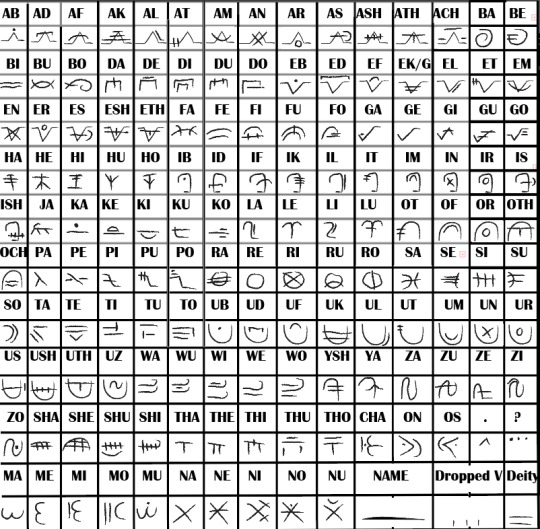
The Kisho-Shabalic script is syllabic, thus each symbol is representative of one syllable composed of a consonant and a vowel. In addition there are characters used to symbalize the conclusion of a thought, in similar fashion to the Latin "." and "?", and the presence of a proper noun or divine status.
Vowels
As a general rule when transcribing the Kishic script, when two of the same vowel are put next to one another, they are treated as a single vowel, rather than elongated as we might see in English with words like book or meet. Two different vowels, as if O and E, E and A, and so on, are almost never put directly beside each other. In the rare instances when this does occur the "stronger" of the two vowels will cover the other. The order of greatness from least to greatest is as follows:
i-e-a-o-u
e.g. the substantive "the talk" Akki- (verb) + -ul (substantive ending) Akkiul Akkiul Akkul
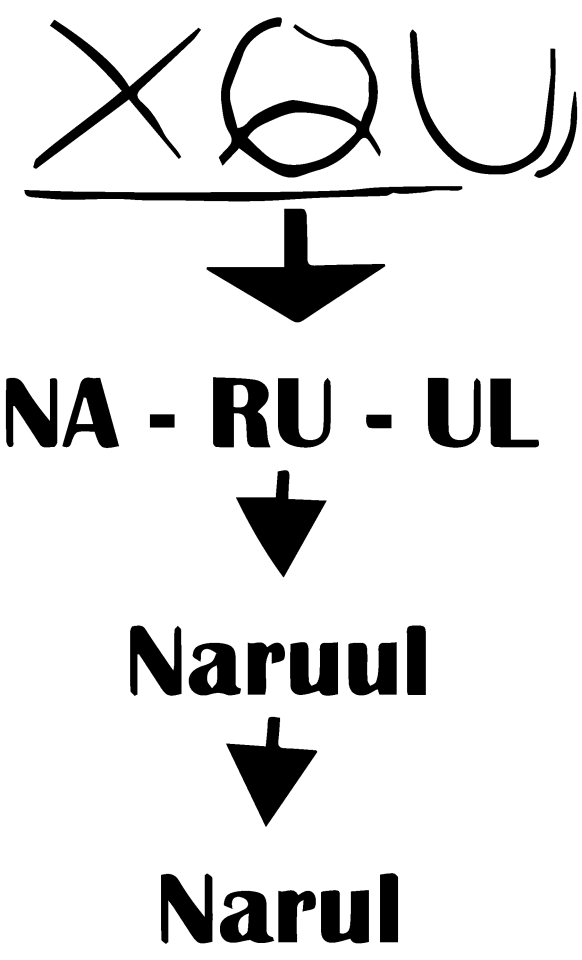
Special Note: One important differentation between the Shabalic language and the Kishic language is that the Kishic language allows for the placing of multiple consonants in sequence. Take for example the Kishic name Ninma, in its original Shabalic form it would be Ninama. Because of the fact that Kishic does have this trait, it has developed its own unique form of punctuation, a vowel drop. When placed below one of the syllabograms shown above, it cancels out the vowel, in essence rendering it mute. Ninma could alternatively be spelled using the formulation NI-IN-MA, similiar to how Narul was spelled above, this is largely a matter of personal preference. The more traditional (Shabalic) form is often times considered more in keeping with nobility.
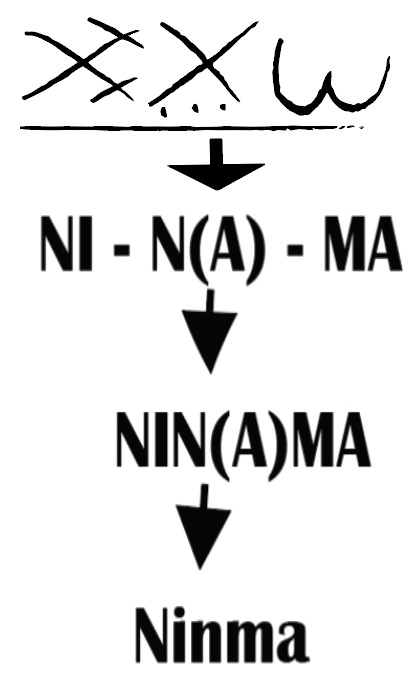
Sentence Structure
The Kishic language primarily follows a subject-object-verb structure.
Nar(u)l Nina(a)ma hara(a)ziga(a)s. Narul Ninma harazigas. Narul Ninma carried. Narul carried Ninma.
Noun and Adjective Declensions
The Kishic language system consists of the following cases: nominative, genitive, dative/accusative, and possessive (the Shabalic language includes an instrumental case), and distinguishes between two numbers (singular and plural) and two genders, Masc (masc/neutral/inanimate) and Feminine.
A few examples of the scheme of suffixation are given in the tables below.
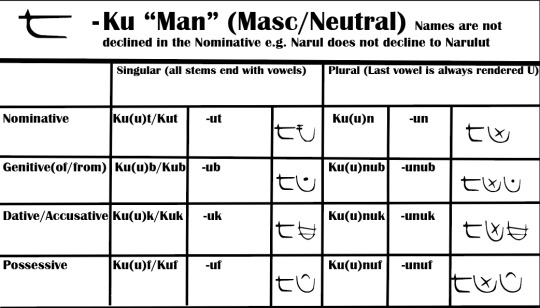
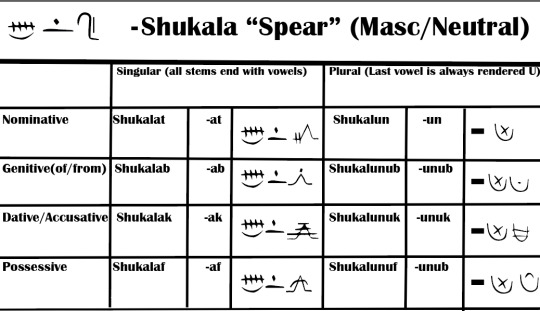
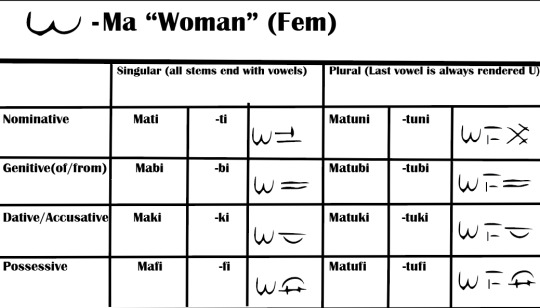
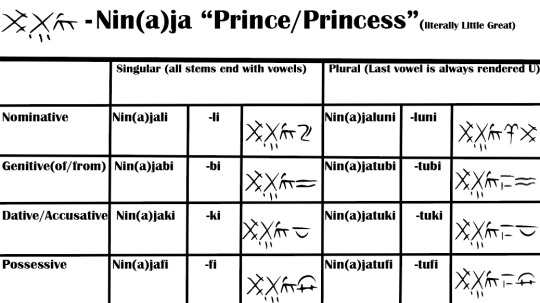
Sample Verb Stems
Verb stems always end with -i.
Talk: Akki
Breathe: Ki
Eat: Ushki
Struggle: Nari
Sleep: Eshsi
Fight: Orishri
Hunt: Pabakazi (Literally Bow art(ing))
Dance: Irteti
Kiss: Mishuzi
Copulate (and the more vulgar equivalent): Seshiti/Tu(u)ki
Verbal Conjugation
There are two general verbal classes according to which verbs are inflected, the aha-conjugation and the awa-conjugation. Within the Kishic language there are two voices (active and medio-passive), three moods (indicative, subjunctive, and imperative), two aspects (perfective and imperfective), and nine tenses (Simple Past, Perfect Past, Continuous Past, Simple Present, Perfect Present, Continuous Present, Simple Future, Perfect Future, Continuous Future).
The present tense can be identified by -i/-a/-u, past by -as, and future by -ad.
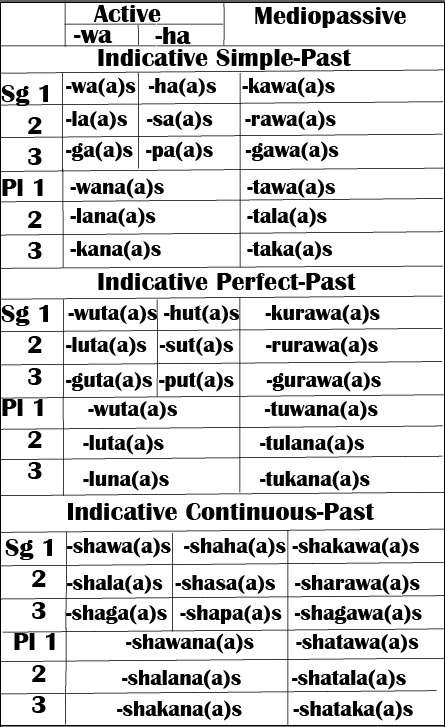
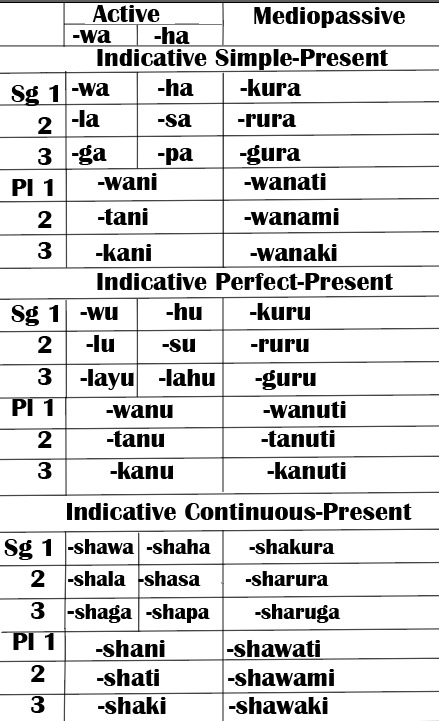

Additionally, the verbal system displays infinitives and participles in the present and past tenses.
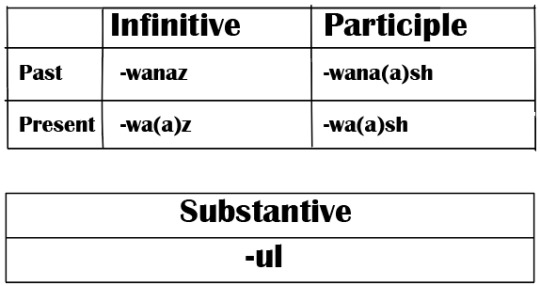
Prounouns


Articles

Sample Sentence
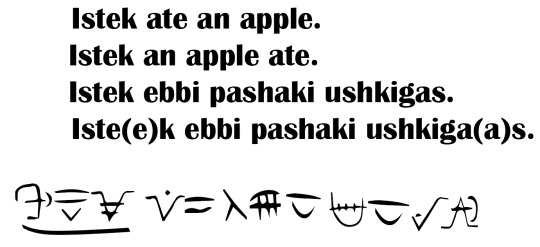
#writeblr#worldbuilding#fantasy#writing#wip#queer fantasy#fantasy world#conscript#fantasy language#fantasy writing#world building#testamentsofthegreensea#conlang#kobaniquestions
22 notes
·
View notes
Note
Languages, always! I know this is a thing lots of writers address, especially nowadays, but: what is the main language of your setting? What are the minority languages? Are they related? How are minority languages treated? How did one language become dominant? What are dialects like, and what are the dialectical differences? What are other languages in your world? Where are they from? Are they related to your main-setting language, or not? If there's a lot of travel, is multilingualism common?
Ohhhh man you hiton one of the things that I’m REALLY interested in, so buckle up!
Okay, first ofall, this world is for a D&D game and while our setting is homebrew it’sstill based heavily on official publications—we work under the assumption thatthings like the Monster Manuals are actual books in-universe, which doesn’tmean that the information they provide is accurate but does mean that certainpeople in the world think it’saccurate.
As such, westarted with the “standard” d&d languages and have beenexpanding/developing out from there! I’m very lucky that one of my players isalso really into linguistics and thus supports my descent into the ConlangWormhole. There’s still less linguistic variation than is truly realistic, justbecause I can’t devote my entire life to developing fantasy languages, but Itry to keep things interesting.
(under a cut because it’s uhhhhhh over a thousand words of Language Babble)
In our setting “Common”actually developed from a pidgin that emerged from interspecies trading a longtime ago. I wanted to have a less imperialist history for this world than what’simplied if Common is just Human Language. For a while it served as a secondarylanguage for dealing with other races, but by the time our campaign takes placeit’s developed into the primary language of the world, especially in placesthat have a lot of international trading. On the continent of Ashona, where ourcampaign is set, nearly everyone learns at least some Common even if it isn’ttheir primary language. It’s represented by English, for obvious reasons. Wehaven’t gotten into a lot of dialectology, but there are innumerable dialectsof Common. The one spoken in the Underdark has diverged enough that it’s nowconsidered a separate language; it has a much stronger Elvish influence thanthe Common of the overlands.
Speaking ofElvish, we use Quenya for that because Tolkien is a much better conlanger thanI’ll ever be. Surface elves tend to be pretty isolationist in this setting, sooutside of Elvish settlements the language isn’t spoken much. However, it isconsidered something of a prestige language, so a lot of arcane scholarship iswritten in Elvish and it’s often taught to nobles of other species. As ageneral rule, wood elves will be impressed if you try to speak to them in theirown language, while high elves will sigh and correct your grammar.
Draconic is the oldestlanguage in this setting because dragons lived on this world before any of thehumanoid species. A lot of geographic features have Draconic names. It’s also alanguage of lore, although dragons themselves don’t tend to write down manylong texts. They do, however, have a script for their language which isdesigned to be scratched into things with claws. Draconic didn’t have a lot ofinfluence on Common because dragons aren’t known for conducting a lot of trade.One of my Dragonborn players and I are in the process of creating a Draconiclanguage! Because our two dragonborn player characters are named Kriv and Voskiwe went with a very Slavic-inspired phonology. High Draconic, the kind spoken byactual dragons, is highly inflected and has several different registers basedon levels of formality and respect. The dialect spoken by most dragonborn haslost a lot of the formality distinctions and sometimes merges the nominativeand accusative cases. Depending on how much contact they’ve had with truedragons, kobold tribes may speak perfect High Draconic or one of several moresimplified dialects.
The Halflinglanguage has the most direct influence on Common and in some areas has mergedwith it. This is represented by the use of more “Anglish” words in Halfing vocabulary—likecalling a school a “learnstead” instead of a “university.” In more isolated areastheir dialects are less comprehensible and I’d represent them with variations onOld or Middle English.
There are severalgeographically distinct Dwarvish languages, but the one spoken in Ashona(sometimes called Conclave Dwarvish because most of its speakers areconcentrated beneath the Conclave Mountains) is represented by Þrjótrunn, analt-lang by Henrik Theiling that imagines a Romance Language based on Icelandic.Anyone who trades with the dwarves is well served to learn their language, soit’s quite well-known even in areas where everyone speaks Common. The dwarvishscript has also been adapted by a number of communities that don’t have anative writing system (such as orcs, who were historically an oral culture buthave come to accept that writing is useful under some circumstances).
Orcish and Goblinare both low-prestige languages, very seldom studied by people who aren’t partof those groups. In mixed-race settlements, orcs and goblins who speakprimarily their native language are considered “uncivilized,” because peopleare gross. I use Laadan (a conlang created by Suzette Haden Elgin as a “woman’slanguage”) for Orcish, primarily out of spite, and Sona (an auxlang based on asmall number of ‘radicals’ that are combined into compounds to make words) forGoblin. Orcish is really good at conveying emotional complexities, and Goblinuses reduplication a lot to convey degrees of intensity. Goblin ALSO has acomplex logographic writing system, but human (etc) anthropologists mistake itfor crude pictograms and insist that goblins can’t write, something which suitsthe goblins fine since they can then leave messages for each other that otherraces will overlook.
Sylvan, the languageof the fae, is the most plot-relevant campaign language, and as such I’m creatingit myself. Because d&d elves are descended from the fae, I used a basephonology similar to the earliest form of proto-Quenya and included a number ofproto-Quenya roots in the vocabulary. I’m in the process of working on thesound shifts that produced “modern” Sylvan. The spoken dialects for Sylvan varywildly, but the written form is quite standardized and has remained that wayfor a long time.
As for languagesof the Outer Planes: Celestial is represented by Hildegard of Bingen’s “LinguaIgnota,” which is really just a cipher of Latin with the nouns swapped out, butwhich I adore. Infernal, the language of devils, is represented by the conlang Lojbanbecause it’s designed to be as exacting and unambiguous as possible (the other extremely Lawful Plane, Mechanus, uses Loglang, which has basically the same structure as Lojban but different vocab, because there was A Schism). The HighInfernal dialect is also used by some Prime Material Plane lawyers when drawingup contracts. There’s also a much more simplified dialect that is the languagespoken by Tieflings and others with fiendish blood. Primordial, the language ofelementals, is represented by SolReSol, a musical conlang, because I wantedsomething with a more alien sound. Also most elementals don’t have mouths.
(We don’t have anyhuman PCs right now so I’ve been spared trying to figure out what they speak.Obviously there are a number of different languages, although there are alsoregions where most humans just learn Common or whatever other language is mostprevalent around them)
#conversations#worldbuilding#you can only get baking soda from HELL#languages#the conlang wormhole#specialagentartemis
33 notes
·
View notes